Applique is a needlework technique used for quickly filling large areas with color and design, accomplished by stitching together cut shapes of cloth to a ground fabric. Onlay is the version which has the cut shapes laid on top of the ground fabric and stitched down. Inlay, also called intarsia, is the technique where the ground fabric is cut and the contrasting pieces are placed under the opening and stitched down. The stitches are often not meant to be seen, and can be covered by some type of cord. In the middle ages this work was at times called “opus consutum” which translates to “sewn together work” (Consutum meaning to sew together: to make by sewing together). “Encyclopedia of Medieval Dress and Textiles of The British Isles” states that quilts also fall into the wide net of this type of needlework (p. 37, Owen-Crocker, et al).
Applique was used on girdles, gloves, pennants, altar cloths, wall hangings, and many other items. Materials can include wool, silk, linen, and other decorative textiles. Wool was often used for both the ground fabric and the decorative cut pieces. The wool fabric for applique could be taken from discarded clothing, in areas where the garment was not overly worn. A good felted wool did not need the edges turned under, as other materials would have. Linen, velvet, silk, and tablet woven bands could also be used for the ground. Any of these same materials could be used for the decorative cut pieces, which were at times richly embroidered themselves. The edging was often covered with a cord which could be made from a metal thread, gilded leather, or silk. In simpler designs the cord serves to provide detail inside the design, as seen in the Tristan Wall-hanging.
The earliest examples of applique embroidery are found in Tutankhamen’s tomb, and Cairo Egypt still has to this day a place called Street of the Tentmakers where the ancient art of applique is alive and well, the name derives from the applique used to decorate tents.
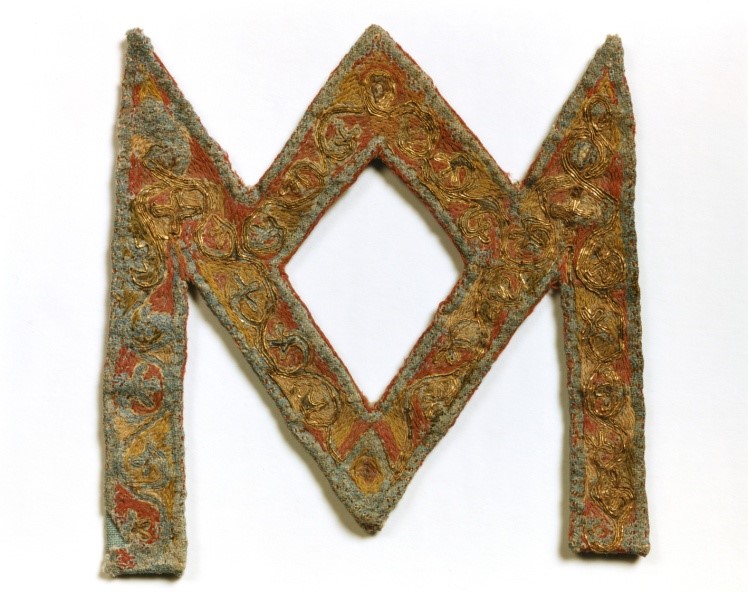
Extant pieces of applique in the middle ages include four pieces dated to approximately 900ce which are part of the Maaseik embroideries located in Belgium which consist of applique of monograms of the Alpha and Omega placed on a painted ground fabric, and which were likely used as an altar cloth.
Photo credit: Makin, Alexandra. “Codex Eyckensis.” September 2017. Sept. 2017. Web. 18 Jan. 2021. http://codexeyckensis.blogspot.com/2017/09/the-maaseik-embroideries.html
The well-known Great Seal bag of Edward I attached to a charter dated Nov 1280, is a wonderful example of intarsia applique with the green ground cut to allow the red shield to show through.
There is another extant piece in Sweden dated to 15th century, and like the Tristan hanging, is a wall hanging made of wool ground, wool motifs, and gilded leather cord providing detail.
The V&A has a wall hanging known as the ‘Tristan hanging” which dates to the 14th century, The Tristan hanging has a worsted wool ground with cut wool motifs applied, then outlined with a gilded leather cord. Wall hangings of this type were popular before tapestry looms were producing wall hangings.

The Tristan appliqued embroidery is very large, it is about 43 inches tall and about 101 inches wide, or 3 1/2 feet tall and 8 1/2 feet wide. The individual blocks are around 16-18 inches almost square. A good size to serve it’s purpose of covering a bare wall with a colorful and impressive story told in pictures.
As we see in other applique works, this was most likely made from wool that had previously been part of a garment. I could not find information regarding the type fiber the thread was made of, so silk or linen are both possibilities. The gilded leather cord outlining and defining the images, is quite interesting. This would have been used as a less expensive alternative to richness of metal thread embroidery, the gilded leather being more affordable to middle class households.
For this project I experimented with how to do the leather cord. I did not have parchment available which was one possibility for the fine strips of leather. I could not see how parchment would make the corners that are visible on details photos of the Tristan hanging. Parchment does not mold to other shapes, it will fold, and possibly roll though, so that continues to be a possibility. The couching thread makes a distinct depression in the leather at each stitch as well. The leather strips or cord also seem to roll or twist in places.


The sharp corners of the trefoil above looked like a molded leather to me. Having worked with veg tanned leather previously, I decided to purchase a small piece of very thin veg tanned leather. I received a piece that is 0.8mm thick, and I sliced it into about 18 strips per inch.
(Materials list found at the end of this post)
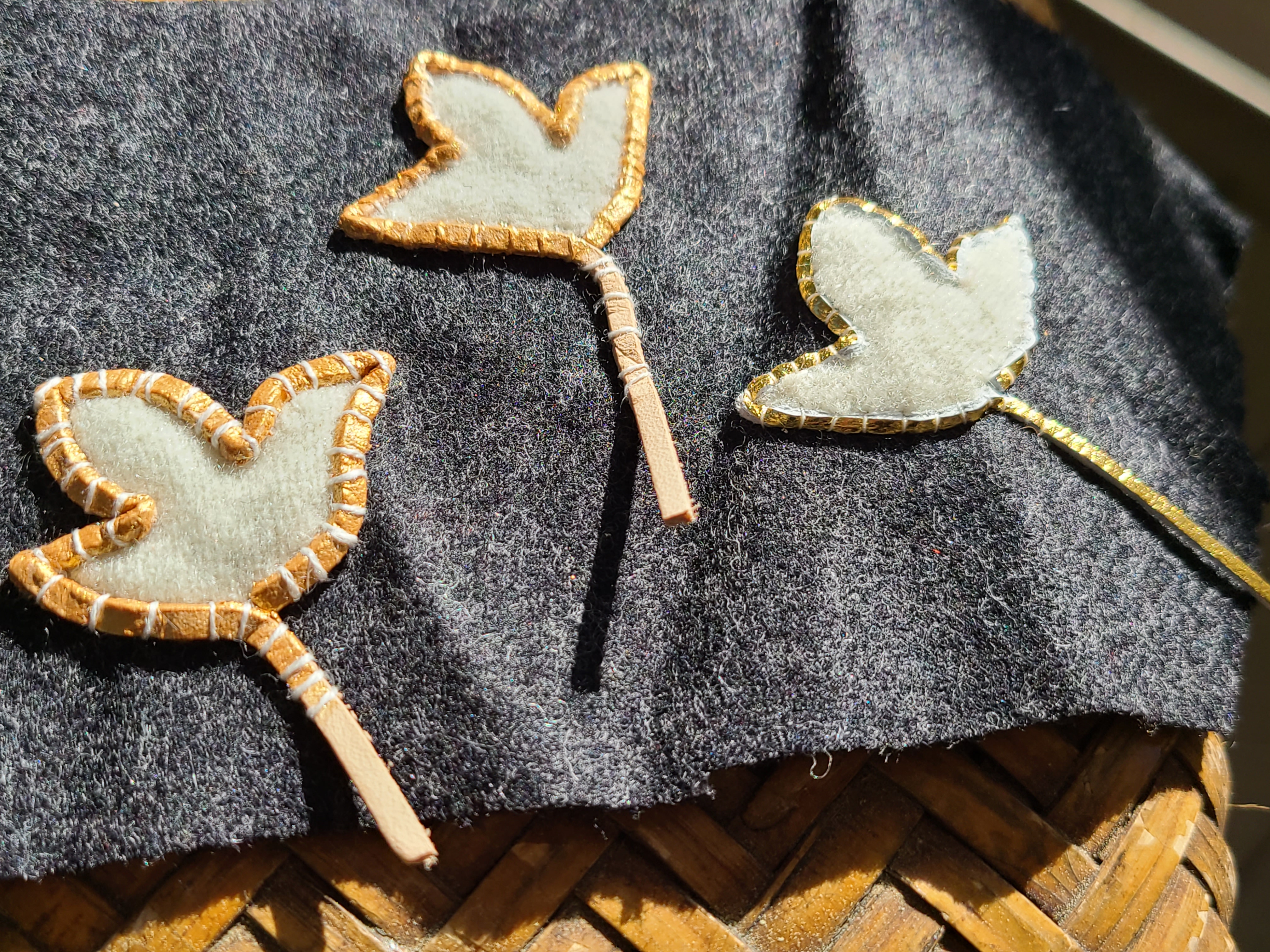
I then tried three sample trefoils to see how it worked. The trefoil on the far right was leather gilded at the factory. It had a ‘square’ shape that was difficult to keep the gold from tilting outwards, so that whether it appeared to be gold depended on your viewing angle.
The other two trefoils were done with a piece of the veg tanned leather (a piece that I had cut a little too thick for the actual project, which is why it’s a bit clunky in this sample). I wet the leather before stitching it down. I used linen thread on the left trefoil and painted it before couching it, and silk thread on the middle trefoil and painted it after couching. The gilding is gold paint. I decided to use the veg tanned leather for this project, since it seemed to have the properties of the leather cord in the extant example.
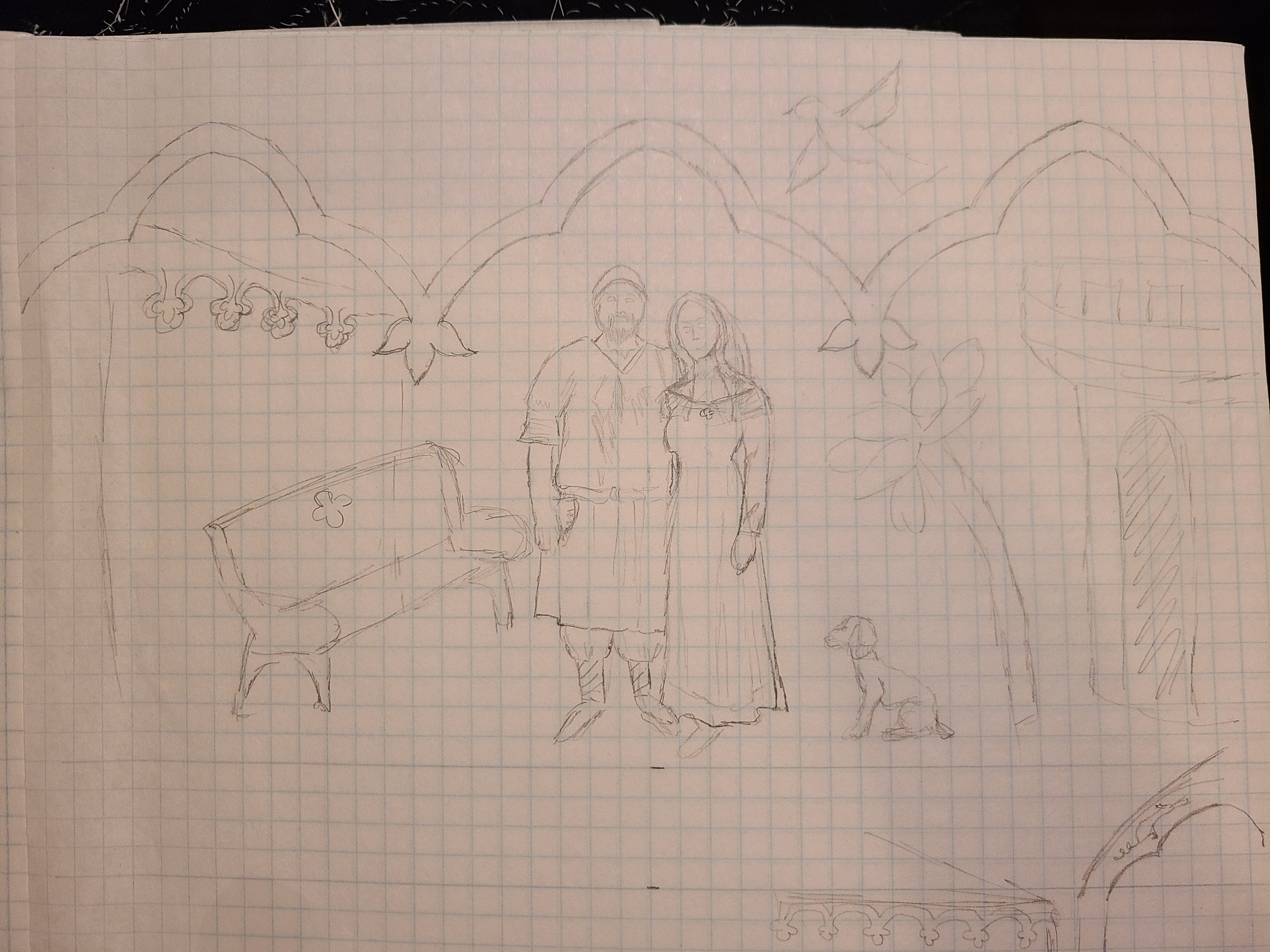
The design I chose is in the spirit of the original, telling a story, and uses elements of the extant piece. You find architectural details used in much medieval embroidery, which are the arches on the Tristan hanging. I used the arches, and birds that were found throughout the Tristan hanging, as well as the dragon that Tristan battled. I substituted aspects of my camp, with the entry gate on the right of this embroidery, a pavilion on the left, and myself and my partner in the center, with our dog next to us.
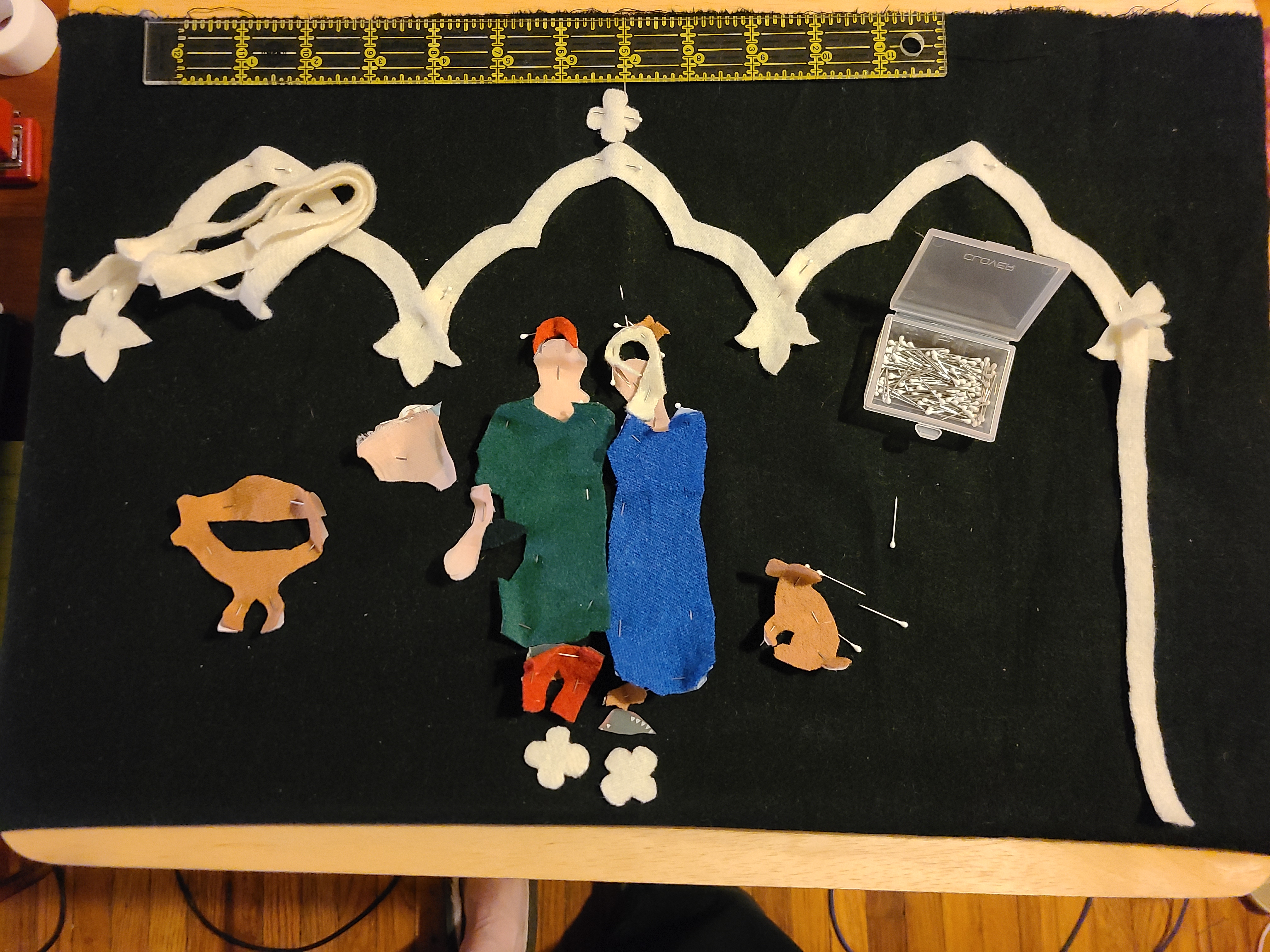
I drew the pieces out on paper first, then pinned the pieces of paper to the bits of wool, all of which was scraps from prior projects, and cut them out. Appliqued the wool cut outs onto the ground fabric with whip stitch in a fine linen thread.
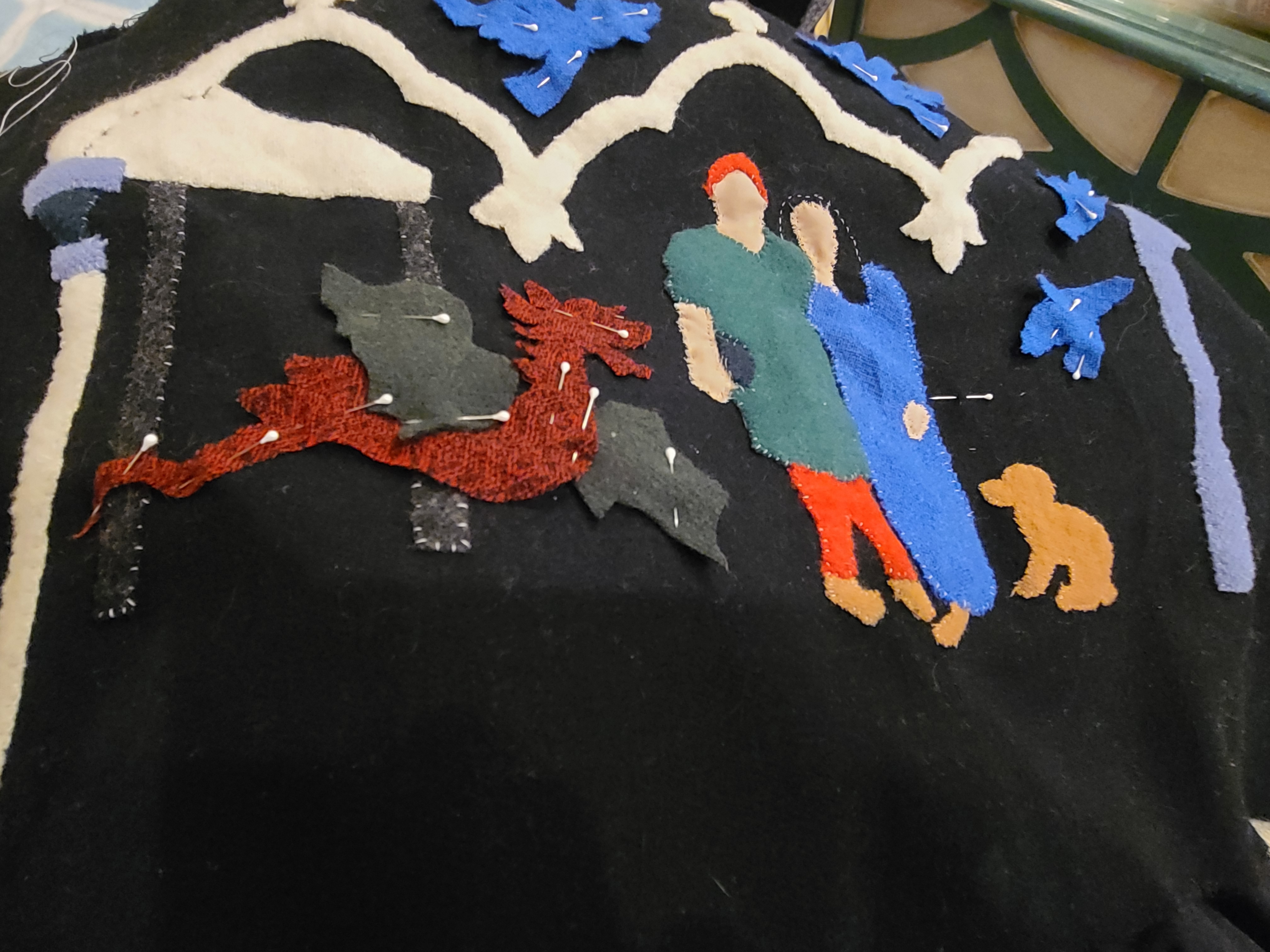
Some design changes happened between the sketch to the final design. The dragon is sketched from one of the dragons on the extant Tristan hanging.
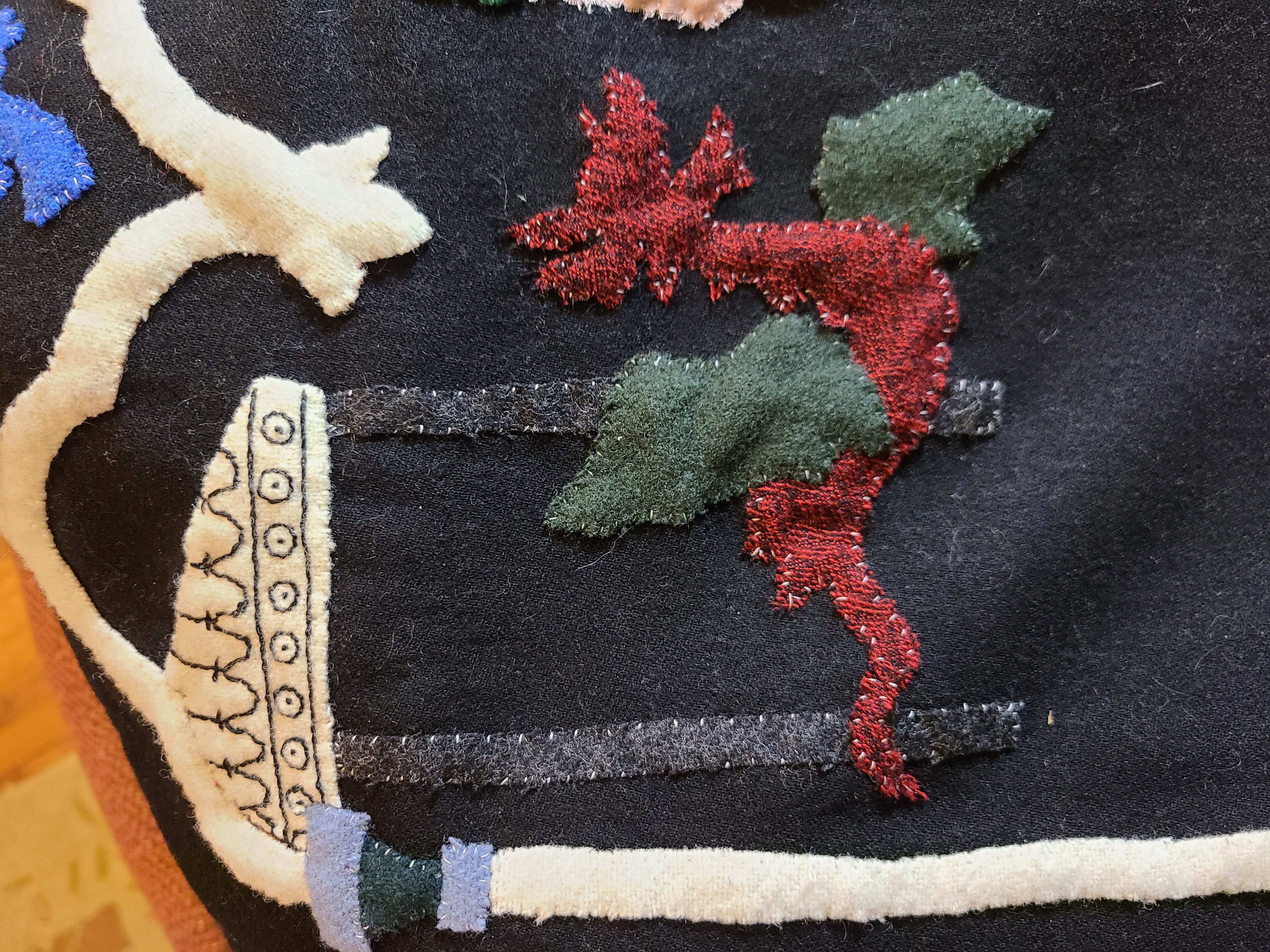
The extant wall hanging has embroidery in what appears to be silk thread used for certain details like the dragon’s fire, and a chess board. I embroidered a couple details with silk thread in this piece as well. First is the pavilion roof.
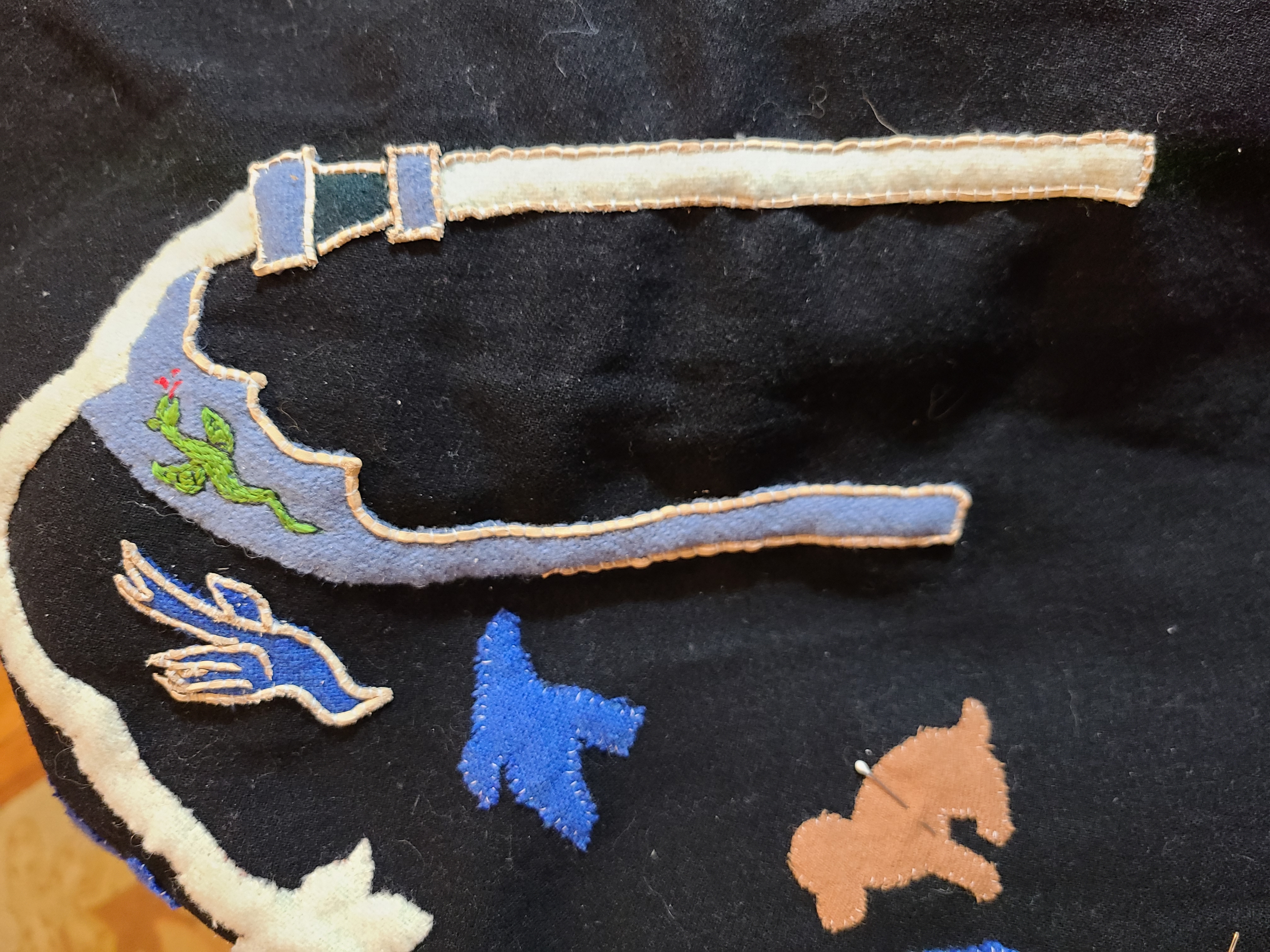
Then I embroidered the green dragon on the camp gate. After the embroidery was done, it was time to apply the leather cording. You can see in the photo how sharp the corners were able to be made using this type of leather. The leather was dampened first. couching was done with a single strand white silk thread. The couching stitches left a slight depression on the leather just as they did on the extant piece. A pair embroidery tweezers were used to help shape the corners. As the leather dried it stiffened into the shape.
My only remaining problem with the leather is how the gilding is applied. I think it is more likely it was done prior to applying the leather to embroidery in period, though I could not find evidence either way. The extant piece would need to be closely examined to determine if there is gilding on top of the couching threads. I found it easier to put the gold paint on after the leather was applied to the embroidery. Painting it first made it stiff, and difficult to mold to the shapes and corners needed of outlining. I think this would have been true in period as well, since gilding is applied after using some type of glue or size to hold the gold leaf.
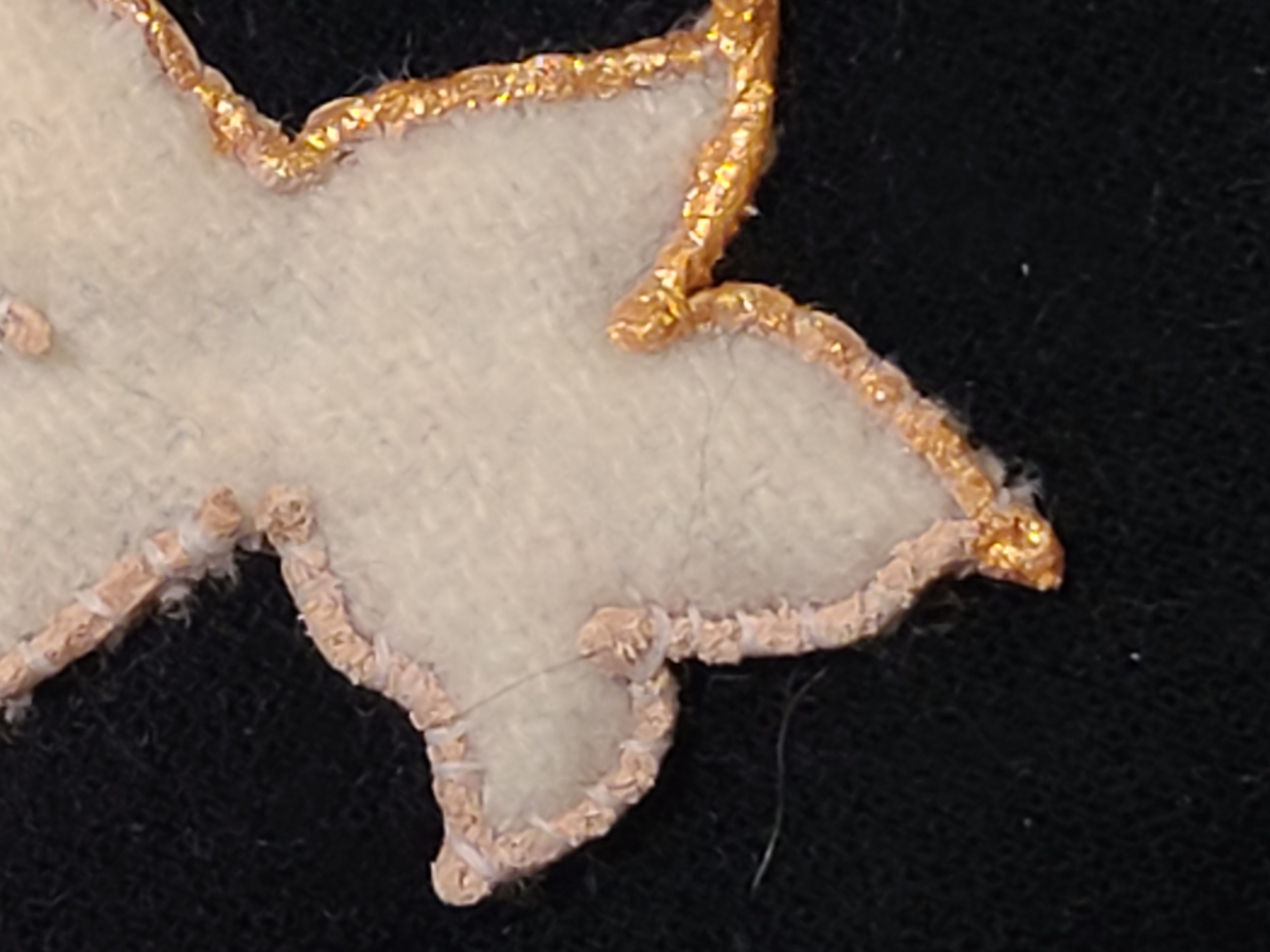
This is one of the trefoils where you see how the leather seems to fold over on itself to round corners. I started to apply the gold here. You can also see here, how the leather seems to be rolling as it couched into place, also similar to the leather on the extant piece.
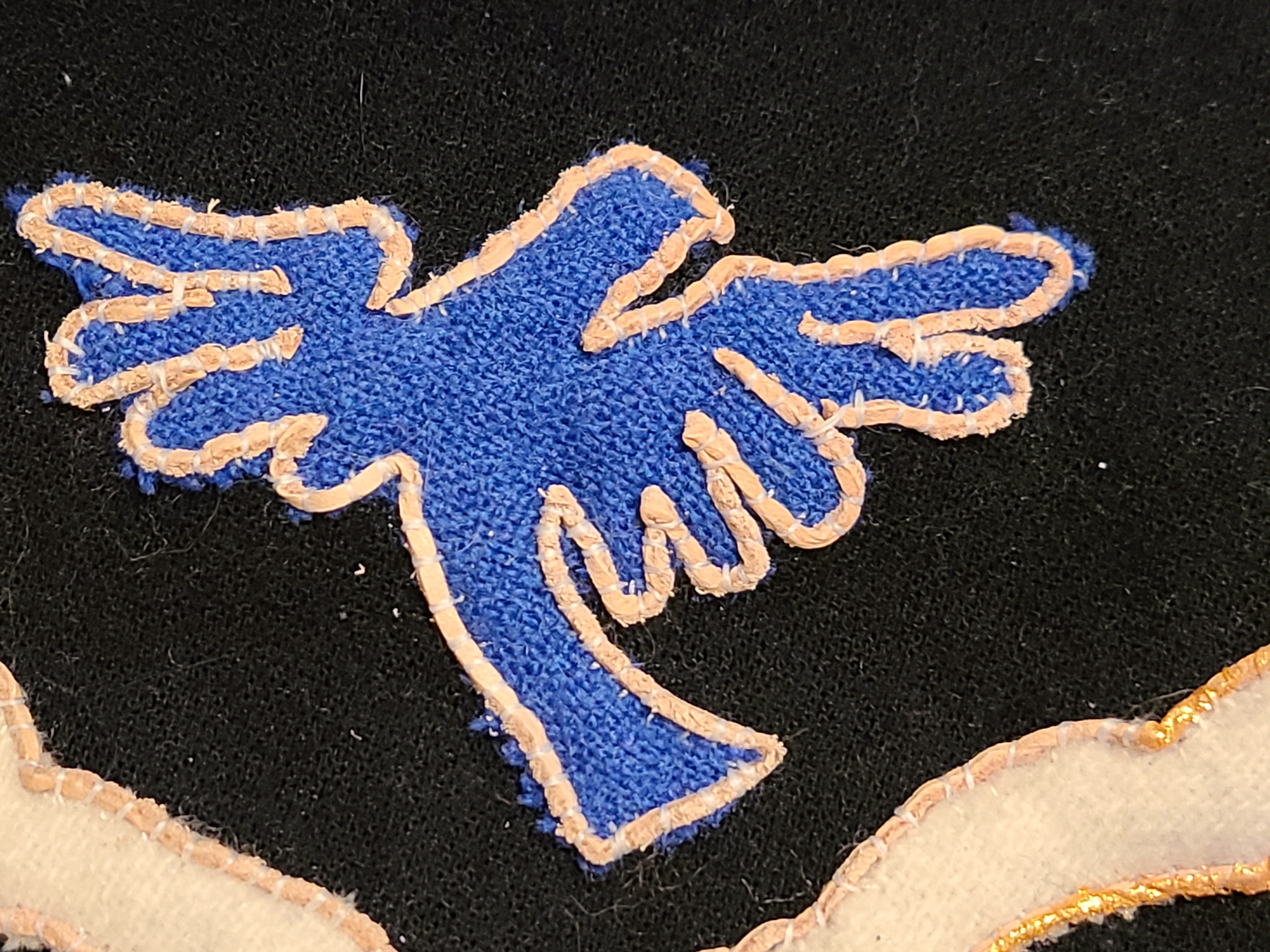
These leather strips worked very well on the details of the birds. This bird measures about 3 inches across wing tips, each feather is about 1/4 inch wide.
This piece is still in progress, but it has definitely been a learning experience. I have not yet seen the Tristan wallhanging in person, though I hope to one day. I have the good fortune to have a friend who has seen it, and took a number of very good pictures, and I am very grateful for her granting the permission to use her photos, so a large thank you to Kandy Fling for her contribution.
I may someday in the future try to use the parchment that was suggested as a possibility of what the leather strips are made of. I also may purchase a good wool flannel cloth in white, and dye colors to use for projects such as this. I am certain some of my wool scraps are only part wool, meaning that it did not felt well, and had a tendency to fray.
I could not find any scholarly articles that studied this textile closely. I will continue to search for articles because I would like to know more about the leather, the gilding, and other materials that were used.
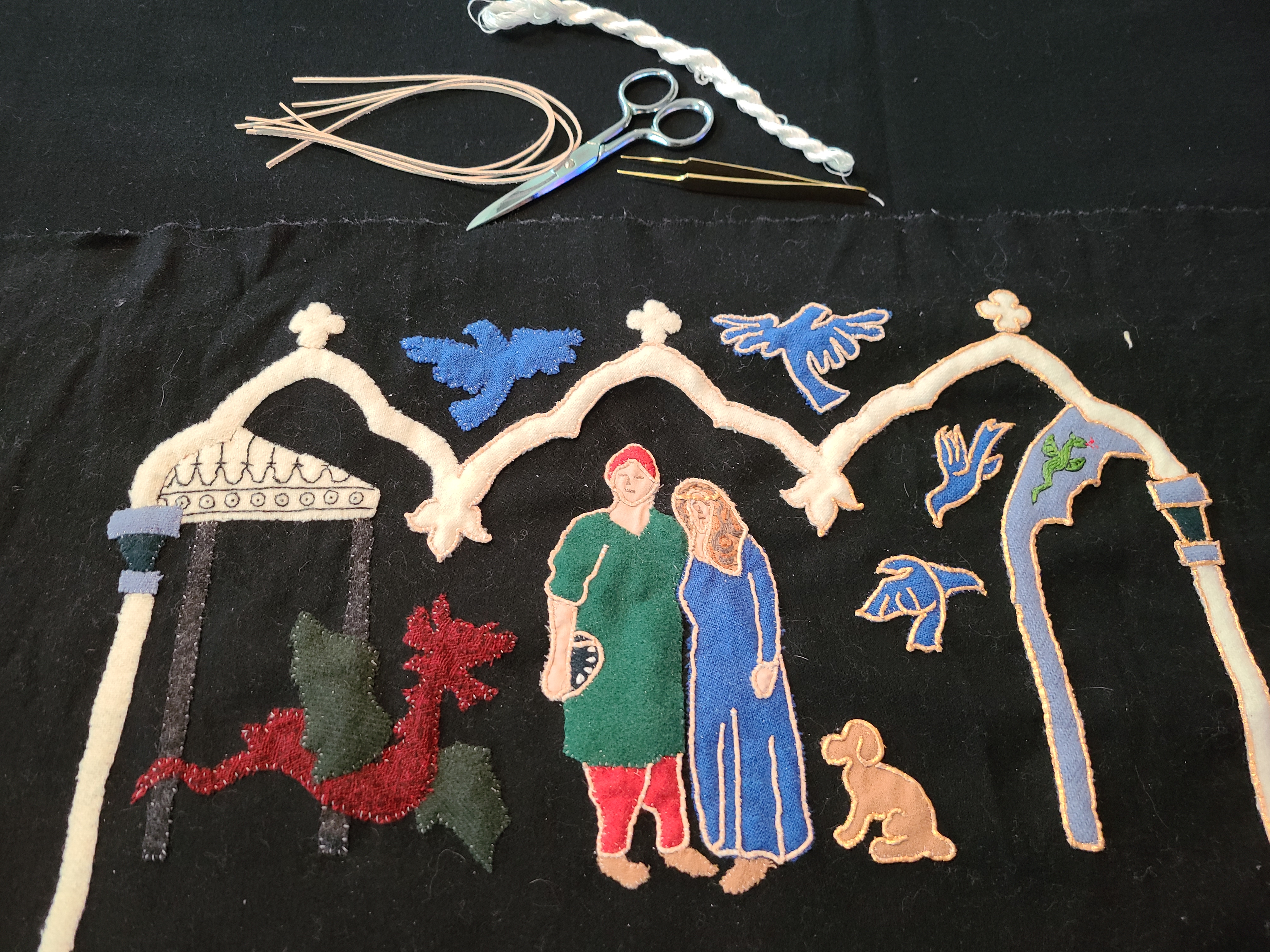
Materials list:
- Wool plain weave fabric, scraps
- Linen thread
- Silk thread
- Veg tanned leather strips
- Metallic gold paint-Cova color
Bibliography:
Makin, Alexandra. “Codex Eyckensis.” September 2017. Sept. 2017. Web. 18 Jan. 2021. http://codexeyckensis.blogspot.com/2017/09/the-maaseik-embroideries.html
Owen-Crocker, Gale R., et al. Encyclopedia of Dress and Textiles in the British Isles c. 450-1450. Brill, 2012.
Staniland, Kay. Medieval Craftsmen: Embroiderers. London: British Museum, 1994. Print.
“The Tristan Hanging (Hanging).” V&A Search the Collections. Web. 18 Jan. 2021. http://collections.vam.ac.uk/item/O86303/the-tristan-hanging-hanging-unknown/
“Visa Föremål: Sök I Samlingarna: Historiska Museet.” Startsida. Web. 18 Jan. 2021. http://mis.historiska.se/mis/sok/fid.asp?fid=96346&page=2&in=1
Willem. “Tristan Hanging.” Tristan Hanging. TRC – Wiki, 02 Jan. 2017. Web. 18 Jan. 2021. https://www.trc-leiden.nl/trc-needles/individual-textiles-and-textile-types/secular-representations/tristan-hanging


